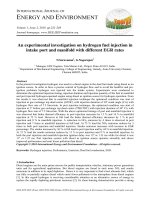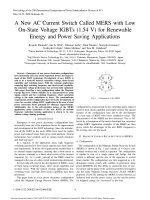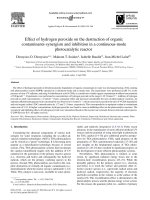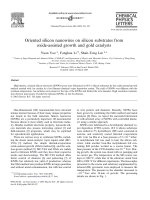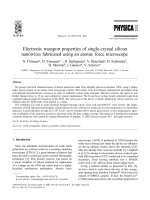- Trang chủ >>
- Khoa Học Tự Nhiên >>
- Vật lý
WO3nanowires on carbon papers: electronic transport, improvedultraviolet-light photodetectors and excellent field emitters
Bạn đang xem bản rút gọn của tài liệu. Xem và tải ngay bản đầy đủ của tài liệu tại đây (1.2 MB, 7 trang )
www.rsc.org/materials
Registered Charity Number 207890
Research highlight from Jong-Heun Lee’s group at
Korea University in Korea and Guozhong Cao’s group
at University of Washington in USA.
Title: Template-free solvothermal synthesis of hollow hematite
spheres and their applications in gas sensors and Li-ion batteries
Fe
3
O
4
hollow spheres were prepared by amino-acid-mediated
solvothermal reaction, which were converted into nearly
monodisperse Fe
2
O
3
hollow spheres with nano-scale thinness by
heat treatment. The well-de ned hollow Fe
2
O
3
spheres showed
signi cantly enhanced C
2
H
5
OH sensing characteristics and
promising Li-ion intercalation behavior.
As featured in:
See H J. Kim et al.,
J. Mater. Chem., 2011, 21, 6549.
0959-9428(2011)21:18;1-I
ISSN 0959-9428
www.rsc.org/materials Volume 21 | Number 18 | 14 May 2011 | Pages 6429–6752
Volume 21 | Number 18 | 2011 Journal of Materials Chemistry Pages 6429–6752
PAPER
Liang Li et al.
WO
3
nanowires on carbon papers:
electronic transport, improved
ultraviolet-light photodetectors and
excellent eld emitters
Downloaded by Sungkyunkwan University on 13 June 2011
Published on 03 March 2011 on | doi:10.1039/C0JM04557H
View Online
WO
3
nanowires on carbon papers: electronic transport, improved
ultraviolet-light photodetectors and excellent field emitters†
Liang Li,
*
a
Yong Zhang,
b
Xiaosheng Fang,
a
Tianyou Zhai,
a
Meiyong Liao,
c
Xueliang Sun,
*
b
Yasuo Koide,
c
Yoshio Bando
a
and Dmitri Golberg
*
a
Received 28th December 2010, Accepted 8th February 2011
DOI: 10.1039/c0jm04557h
Single-crystalline WO
3
nanowires were synthesized on carbon papers through a chemical vapor
deposition process without using any catalysts. WO
3
nanowire field-effect transistors (FETs) were
constructed to discuss the mechanism of electronic transport based on a thermal-activation model and
a displacive transition. Photoconductive measurements showed that individual WO
3
nanowire
photodetector was sensitive to the ultraviolet light, and the photoresponse was further improved using
WO
3
nanowires on carbon papers, demonstrating significantly shortened response and decay times,
and enhanced stability. Field-emission measurements showed that WO
3
nanowires were excellent field-
emitters: an ultralow turn-on field of 1.8 V mm
À1
and a threshold field of 3.3 V mm
À1
, and a high field-
enhancement factor of 6.9 Â 10
3
. These results indicate that present unique WO
3
nanowires on carbon
papers are promising candidates for constructing high-performance electronic and optoelectronic
devices.
Introduction
In the family of transition metal oxides, tungsten trioxides (WO
3
)
have attracted wide attention and substantial efforts have been
devoted to fabricate one-dimensional (1D) WO
3
nanostructures
for field emission, gas sensing, electrochromism, and photo-
catalysis.
1
The outstanding properties make WO
3
nanowires
valuable as functional building blocks for the fabrication of
optoelectronic nanodevices. Therefore, the investigation of
electronic transport mechanisms of individual WO
3
nanowires is
very important.
2
To accurately measure transport behaviors of
WO
3
nanowires, it is essential to form ohmic contacts between
nanowires and electrodes. However, this has achieved little
success except for a recent work utilizing N-doped WO
3
nano-
wires to increase carrier concentration.
2
1D oxide semiconductor nanomaterials are promising for
field-emission applications due to their large aspect ratio, low
work function, high mechanical stabilities, and high electrical
and thermal conductivities.
3
The field-emission properties of 1D
WO
3
nanostructures have been investigated recently, as shown in
Table 2.
2,4
However, to meet demands of practical applications it
is necessary to explore novel WO
3
nanostructures for further
decreasing turn-on and threshold fields, increasing emission
current density, and enhancing field-enhancement factor.
According to the range of wavelength, UV light is classified
into UV-A (320–400 nm), UV-B (290–320 nm), and UV-C (200–
290 nm), among which the UV-A light can easily reach the
Earth’s surface and may cause a skin cancer. Different from
the visible light, people’s eyes are blind to the UV-A light. Thus,
the development of effective UV-A photodetectors (light sensors)
is of great importance. With a wide bandgap E
g
z 3.3 eV, WO
3
is applicable for detecting UV-A light. Up to now, there has
been only a single literature with respect to the individual
nanostructured WO
3
photodetector,
5
which showed the rela-
tively slow response time of $1 min. Thus, it is interesting to
develop novel routes to optimize the performance of WO
3
photodetectors.
Herein, we fabricated the individual WO
3
nanowire field-effect
transistors (FETs), from which the electrical transport mecha-
nism was investigated based on temperature-dependent resis-
tances. The individual WO
3
nanowire photodetectors showed
sensing capability to UV-A light. Furthermore, we report
a photoconductive nanodevice structure made of WO
3
nano-
wires on carbon papers, which demonstrated largely improved
stability and shortened response time. Such novel hierarchical
nanostructures were then used as excellent field-emitters: an
ultralow turn-on field of 1.8 V mm
À1
and threshold field of 3.3 V
mm
À1
, and a high field-enhancement factor of 6.9 Â 10
3
were
documented. These are the best field-emission parameters in all
reported 1D WO
3
nanostructures. Our results demonstrate the
a
International Center for Materials Nanoarchitectonics (MANA),
National Institute for Materials Science (NIMS), Namiki 1-1, Tsukuba,
Ibaraki, 305-0044, Japan. E-mail: ; Golberg.
b
Department of Mechanical and Materials Engineering, University of
Western Ontario, London, Ontario, N6A 5B9, Canada. E-mail: xsun@
eng.uwo.ca
c
Sensor Materials Center, NIMS, Namiki 1-1, Tsukuba, Ibaraki, 305-
0044, Japan
† Electronic supplementary information (ESI) available. See DOI:
10.1039/c0jm04557h
This journal is ª The Royal Society of Chemistry 2011 J. Mater. Chem., 2011, 21, 6525–6530 | 6525
Dynamic Article Links
C
<
Journal of
Materials Chemistry
Cite this: J. Mater. Chem., 2011, 21, 6525
www.rsc.org/materials
PAPER
Downloaded by Sungkyunkwan University on 13 June 2011
Published on 03 March 2011 on | doi:10.1039/C0JM04557H
View Online
uniqueness and effectiveness of WO
3
nanowires on carbon papers
for optoelectronic applications.
Experimental
Material preparation and characterization
Uniform and aligned hierarchical WO
3
nanowires on carbon
papers were synthesized by an improved chemical vapor depo-
sition process without using catalysts.
6
The carbon paper coated
with tungsten film was placed in the middle part of a quartz tube
that was mounted horizontally inside a furnace. A carrier gas of
high-purity Ar was passed through the quartz tube at a rate of
300 sccm (standard cubic centimetres per minute) for half an
hour to purge the oxygen. After that, water vapor was introduced
into the chamber with Ar and the system was heated to 750
C
for 1 h to induce the growth of tungsten oxide nanowires. After it
was cooled to room temperature in the flowing carrier gas,
the samples were annealed in air at 500
C for 1 h to obtain WO
3
nanowires. The as-prepared WO
3
nanowires were analyzed by
X-ray diffraction (XRD, Ultima IV/PSK), field-emission scan-
ning electron microscopy (FE-SEM, Hitachi S-4800), and
high-resolution transmission electron microscopy (HRTEM,
JEM-3000F).
Device fabrication and properties
For field-effect transistor (FET) device fabrication, WO
3
nano-
wires were suspended in ethanol and then deposited on an
oxidized Si substrate with a 200 nm thick SiO
2
layer that serves as
a gate oxide. The standard photolithography technique followed
by metal evaporation and lift-off procedures were used to define
the source and drain electrodes and to electrically contact WO
3
nanowires. The I–V characteristics were recorded by room and
low temperature (Nagase Electronic Equipments service, co.)
probing systems and a semiconductor parameter analyzer
(Keithley Instruments Inc).
For individual WO
3
nanowire photodetector fabrication, the
FET device without gate voltage was illuminated with a light of
different wavelengths at ambient atmosphere, and the photo-
current was recorded using a picoammeter R8340A and a dc
voltage source R6144. A spectral response was recorded using
a 500 W Ushio Xenon lamp with an illumination band width of
2 nm, and a monochromator with order sorting filters used. The
light intensity was modulated through an aperture and calibrated
by using a UV-enhanced Si photodiode.
Field-emission measurements were performed in a vacuum
chamber at a pressure of 3 Â 10
À6
Pa. The WO
3
nanowires on
carbon papers were directly attached to a cathode, and a Cu
prober with a cross-section of 1 mm
2
was used as an anode. A
dc voltage sweeping from 100 to 1100 V was applied to the
samples, and a corresponding electronic current was recorded
automatically.
Results and discussion
Fig. 1 shows the morphology, microstructure, and elemental
maps of as-fabricated WO
3
nanowires. A low-magnification
scanning electron microscopy (SEM) image reveals highly
uniform and aligned hierarchical nanowires on carbon fibers
(Fig. 1a). High-density WO
3
nanowires are covered on the whole
carbon paper (the inset in Fig. 1a). Higher-magnification SEM
image shows that dense and quasi-aligned nanowires intersect
each carbon fiber throughout (Fig. 1b). An X-ray diffraction
(XRD) pattern indicates that WO
3
nanowires have a monoclinic
phase (JCPDS card No. 89-4476) (Fig. 1c). A high-resolution
transmission electron microscopy (HRTEM) image and
a selected-area electron diffraction (SAED) pattern (Fig. 1d and
insets) indicate that nanowires are single crystals with the preferred
[002] growth direction. Fig. 1e and 1f show the elemental maps of
individual nanowires, indicating uniform distribution of the
constituting W and O elements.
Fig. 2a represents a typical SEM image of an individual WO
3
nanowire FET device. The WO
3
nanowire was connected by Cr/
Au electrodes patterned on a SiO
2
/Si substrate using a standard
photolithography process. The current–voltage (I–V) curves
under different gate voltages (V
g
) are shown in Fig. 2b. The linear
curves indicate the good Ohmic contacts between the WO
3
nanowire and the electrodes. It can be seen that the conductance
of nanowires increases monotonically as the gate voltage
increases, indicating an n-type character of the as-fabricated
nanowires. The transfer characteristic of FET is weak (not
shown here). Electrical transport mechanism was investigated by
the temperature-dependent resistance (R-T) measured on the
FET device without applying gate voltages. Fig. S1 (ESI†) shows
the I–V characteristics of WO
3
nanowires in the temperature
range of 10–296 K. The linear I–V curves show that the char-
acteristics fit the Ohm’s law, from which the resistivity of the
nanowire can be calculated as r ¼ (R Â S)/L (r: resistivity, R:
resistance, S: cross-sectional area, L: length of the nanowire).
Assuming that the WO
3
nanowires are of circular cross section,
the calculated resistivity is $18.2 U cm at room temperature.
Fig. S2 shows the I–V characteristics measured from eight
devices labeled from S0 to S7 in Fig. S3. Clearly all the devices
comply with Ohm’s law. The diameters of the nanowires vary
from 95 nm to 140 nm. The calculated resistivities of the nano-
devices are listed in Table 1. The resistivity values are between
18.2 U cm and 70.6 U cm.
Based on I–V results, the R–T curve (Fig. 2c) was plotted. It
demonstrates the typical semiconductor character except for
a phase transition near 45 K. In general, the electronic transport
of transition-metal oxides is governed by the hopping conduction
mechanism and the electrons are the major carriers via the
oxygen vacancies. The thermal-activation model predicts that the
conductivity follows the equation
7
s ¼ s
0
exp
ÀDE
kT
(1)
where s is the conductivity, k is the Boltzmann constant, and DE
is the activation energy. The linear curve (ln(1/R) z 1000/T)in
Fig. 2d suggests that the transport mechanism is dominated by
thermal activation at relatively high temperatures (45–296 K).
From the slope of this curve, the activation energy of DE $ 0.06
eV is estimated. The extremely low activation energy implies
good conduction capability of an individual WO
3
nanowire.
Near 45 K, resistance anomaly is observed, possibly arising from
a displacive transition that also occurs in the bulk WO
3
single
crystals.
8
Phase transitions in tungsten trioxide are often asso-
ciated with distortions of the oxygen octahedral that surround
6526 | J. Mater. Chem., 2011, 21, 6525–6530 This journal is ª The Royal Society of Chemistry 2011
Downloaded by Sungkyunkwan University on 13 June 2011
Published on 03 March 2011 on | doi:10.1039/C0JM04557H
View Online
the heavy W atoms, and with changes in unit cell multiplicity.
8,9
In a low-temperature region (T < 25 K), ln(1/R) is independent
of temperature, which indicates that the number of thermal-
activation carriers is too low to affect the total amount of
carriers.
Fig. 3a shows a schematic measurement configuration of an
individual WO
3
nanowire photodetector. A monochromatic
light was introduced to vertically illuminate the nanowire and the
corresponding I–V curves were recorded. Fig. 3b shows the
responsivity of the WO
3
nanowire measured at 1.0 V. With
decreasing wavelength, the sensitivity increases gradually and
reaches the maximum value at $375 nm (3.3 eV, close to
bandgap of WO
3
) and then drops, implying a band-gap excita-
tion related process. The decreased sensitivity at a wavelength
shorter than 375 nm is attributed to the enhanced absorption of
high energy photons near the surface region of the semi-
conductor.
10
Fig. 3c shows the I–V curves of the photodetector
illuminated with a light of various wavelengths and under dark
condition. A photo-excited current is higher than the dark
current. All these results indicate that the present photodetector
demonstrates a selectivity and sensitivity towards the UV-A
light. To examine the reproducibility of individual WO
3
nanowire photodetectors, we randomly measured the photo-
response of devices S3 and S4 (Fig. S4, ESI†). It can be clearly
seen that these curves have the similar varying trend with
decreasing wavelength of light from 380 nm to 250 nm, implying
the same bandgap-excited sensing mechanism.
Photoresponse depends on the light intensity. Fig. 3d repre-
sents I–V curves of the nanowire illuminated by a 375 nm light
with various intensities from 0.08 to 1.65 mW cm
À2
. The corre-
sponding dependence of a photocurrent on light intensity can be
fitted to a power law (Fig. 3e), I
p
$ P
q
, where q determines the
response of the photocurrent to light intensity. The fitting gives
a nearly linear behavior with q ¼ 1.0.
The photoresponse switching behavior of the WO
3
nanowire
photodetector is shown in Fig. 3f, which illustrates that the
photocurrent can be reproducibly switched ‘‘ON’’ and ‘‘OFF’’ by
periodically modulating the 375 nm light at a low bias voltage of
10.0 V. From this response curve, it is difficult to estimate
response and decay times (t
r
and t
d
) (the time for the current
increasing from 10% to 90% of the peak value or vice versa is
defined as the t
r
and t
d
, respectively), because we cannot observe
stable platforms of the photocurrent and the dark current during
a period of measurements. In general, under the dark condition,
Fig. 1 (a) Low- and (b) high- magnification SEM images of as-prepared nanowires, and (c) corresponding XRD pattern. (d) HRTEM image and SAED
pattern of an individual WO
3
nanowire. e) O and W elemental maps.
This journal is ª The Royal Society of Chemistry 2011 J. Mater. Chem., 2011, 21, 6525–6530 | 6527
Downloaded by Sungkyunkwan University on 13 June 2011
Published on 03 March 2011 on | doi:10.1039/C0JM04557H
View Online
a low conductance is caused by the depletion layer formed near
the surface by adsorbed oxygen molecules in the n-type semi-
conductor [O
2
(g) + e
À
/ O
2
À
(ad)]. Upon light illumination with
photon energy higher than the bandgap, adsorbed oxygen ions
discharge by photo-generated holes [h
+
+O
2
À
/ O
2
(g)],
enhancing the conductance.
11
Fig. 3g shows the schematic of a photodetector constructed
directly using WO
3
nanowires on carbon papers. The metal elec-
trode on the top surface was fabricated by a mask-assisted electron
beam deposition, and the uncovered area was illuminated by
375 nm light to induce photocurrent. Between the carbon paper
and the top-surface electrode, the nanowire lengths are enough to
join neighboring nanowires and form many nanowire/nanowire
junctions. These junctions act as electrical conducting paths for
electrons. This design is very simple and efficient compared with
an individual nanostructure device. In other words, individual
nanostructure devices are usually fabricated either by tedious and
time-consuming photo or electron-beam lithography processes
including a series of steps such as synthesis, dispersal of nano-
structures, spin coating of photo resist, exposure, and so on.
12
More importantly, such device demonstrated a significantly
improved photoresponse compared with the individual WO
3
nanowire photodetector. Fig. 3h illustrates a time-dependent
photocurrent of this device measured at 10.0 V under a 375 nm-
light ‘‘ON’’ and ‘‘OFF’’. The response and decay times are about
3 s and 20 s, respectively. In comparison with individual WO
3
nanowire photodetectors (Fig. 3f), the response and decay time,
stability, and reproducibility are largely enhanced.
Field-emission measurements show that WO
3
nanowires on
carbon papers are excellent field-emitters. Fig. 4a shows the field-
emission current density J versus the applied field E at an anode-
cathode distance of 250 mm. The current density gradually
increases with increasing voltage, and a turn-on field at a current
density of 10 mAcm
À2
and a threshold field at a current density of
1mAcm
À2
are as low as 1.8 V mm
À1
and 3.3 V mm
À1
, respectively.
To reveal the field-emission mechanism, the corresponding curve
ln(J/E
2
) À (1/E) is plotted (the inset in Fig. 4a) based on the
Fowler–Nordheim (FN) theory:
13
J ¼ (Ab
2
E
2
/f)exp(ÀBf
3/2
/bE) (2)
Here A ¼ 1.54 Â10
À6
AeVV
À2
, B ¼ 6.83 Â 10
3
eV
À3/2
V mm
À1
, f
is the work function of the emitting materials (5.7 eV), and b is
the field-enhancement factor that is related to the emitter
geometry, crystal structure, and spatial distribution of the
emitting centers. Here b is as high as 6.9 Â 10
3
. The linear vari-
ation of ln(J/E
2
) with 1/E (FN plot) confirms that the emission-
current is due to the electron tunneling effect. Stability of the
field-emitters is another important parameter related to potential
applications. Field-emission stability measurement of WO
3
nanowires was performed by keeping a current density at 8.0 mA
cm
À2
over 12 h. As shown in Fig. 4b, there is no large current
degradation or notable fluctuation during this period. The good
emission stability promises that present WO
3
nanowires are good
candidates in the cold-cathode-based panel display devices.
Fig. 2 (a) Typical SEM image of a FET device. The top-right inset is an enlarged view. (b) I–V plots under different gate voltages. (c) A curve of R
versus T. (d) ln(1/R) as a function of 1000/T.
Table 1 Calculated resistivities of eight nanodevices labeled from S0 to
S7
Nanodevices Resistance/MU Resistivity/U cm
S0 76.5 18.2
S1 117.4 46.5
S2 181.4 39.9
S3 156.1 70.6
S4 240.5 35.9
S5 145.5 35.8
S6 111.0 34.5
S7 105.9 34.7
6528 | J. Mater. Chem., 2011, 21, 6525–6530 This journal is ª The Royal Society of Chemistry 2011
Downloaded by Sungkyunkwan University on 13 June 2011
Published on 03 March 2011 on | doi:10.1039/C0JM04557H
View Online
These field-emission parameters are the best among 1D WO
3
nanostructures (Table 2), and even surpass those of other
reported semiconductors such as ZnO, Si, carbon nanotubes, and
so on.
14
Such excellent performances are mainly attributed to
a large aspect-ratio, quasi-aligned arrays, and direct contact
between WO
3
nanowires and conductive carbon papers.
Conclusions
In summary, individual WO
3
nanowire FET was constructed to
investigate the type and mechanism of conductance, which was
discussed in the frame of a thermal-activation model and
Fig. 4 (a) A J–E curve of WO
3
nanowires. The inset is a ln(J/E
2
) À (1/E)
plot from Fowler–Nordheim equation. (b) A stable current emission
over 12 h.
Fig. 3 (a) Schematic of measuring photocondu ctivity on an individual
WO
3
nanowire. (b) Spectral response of the device, demonstrating
a band -gap excited process. (c) I–V curves of the individual WO
3
nanowire photodetector under dark condition and light wit h various
wav elengths. (d) I–V curves of a WO
3
nanowire photodetector under
375 nm light irradiation of various intensities. (e) Photocurrent as
a function of light intensity and corresponding fitting curve using the
power law. (f) Time response of a WO
3
nanowire photodetector. (g)
Schematic of photodetector construct ed directly using WO
3
nanowires
on carbon papers, and (h) corresponding light switching ‘‘ON’’ and
‘‘OFF’’ curve.
Table 2 Comparison of the field-emission parameters between this work and previous studies of 1D WO
3
nanostructures. We define the turn-on and
threshold field at a field producing an emission current density of 10 mAcm
À2
and 1 mA cm
À2
, respectively. If the other values are used, it is marked
ID WO
3
nanostructures
Turn-on
field/V mm
À1
Threshold
field/V mm
À1
Field-enchancement
factor (b) Reference
Nanowires & nanorods 2 — 5.0 Â 10
3
4
13 — 6.7 Â 10
2
4
4.1 — 2.1 Â 10
3
4
3.6 — 2.7 Â 10
3
4
4.8 — — 4
— 4.5 — 4
— 4.3 at 10 mA cm
À2
1.7 Â 10
3
2
6.44 9.42 at 10 mA cm
À2
7.0 Â 10
2
2
1.8 3.3 6.9 Â 10
3
Present work
This journal is ª The Royal Society of Chemistry 2011 J. Mater. Chem., 2011, 21, 6525–6530 | 6529
Downloaded by Sungkyunkwan University on 13 June 2011
Published on 03 March 2011 on | doi:10.1039/C0JM04557H
View Online
a displacive transition. Individual WO
3
nanowire photodetector
showed high potential for sensing UV-A light. Photoconductive
characteristics, including a spectra response, I–V curves under
different light intensities, and time response were studied.
Improved photodetectors were fabricated directly using WO
3
nanowires on carbon papers, demonstrating significantly
enhanced stability and shortened response and decay times.
Field-emission measurements showed that such hierarchical
WO
3
nanostructures have an ultralow turn-on field of 1.8 V mm
À1
and a threshold field of 3.3 V mm
À1
, and a high field-enhancement
factor of 6.9 Â 10
3
. These results demonstrate that WO
3
nano-
wires on carbon papers are promising candidates for construct-
ing novel electronic and optoelectronic nanoscale devices.
Acknowledgements
This work was supported by the International Center for
Materials Nanoarchitectonics (MANA) of the National Institute
for Materials Science (NIMS), Tsukuba, Japan. X. S. Fang
thanks the JSPS financial support (No. 22760517). X. L. Sun
thanks NSERC Canada Research Chair program.
References
1 J. Polleux, A. Gurlo, N. Barsan, U. Weimar, M. Antonietti and
M. Niederberger, Angew. Chem., Int. Ed., 2006, 45, 261; J. Zhou,
Y. Ding, S. Z. Deng, L. Gong, N. S. Xu and Z. L. Wang, Adv.
Mater., 2005, 17, 2107; Z. G. Zhao and M. Miyauchi, Angew.
Chem., Int. Ed., 2008, 47, 7051.
2 M. T. Chang, L. J. Chou, Y. L. Chueh, Y. C. Lee, C. H. Hsieh,
C. D. Chen, Y. W. Lan and L. J. Chen, Small, 2007, 3, 658;
S. J. Wang, W. J. Lu, G. Cheng, K. Cheng, X. H. Jiang and
Z. L. Du, Appl. Phys. Lett., 2009, 94, 263106.
3 J. H. He, T. H. Wu, C. L. Hsin, K. M. Li, L. J. Chen, Y. L. Chueh,
L. J. Chou and Z. L. Wang, Small, 2006, 2, 116; Y. L. Chueh,
L. J. Chou, S. L. Cheng, J. H. He, W. W. Wu and L. J. Chen, Appl.
Phys. Lett., 2005, 86, 133112; J. C. She, Z. M. Xiao, Y. H. Yang,
S. Z. Deng, J. Chen, G. W. Yang and N. S. Xu, ACS Nano, 2008,
2, 2015; Y. H. Yang, B. Wang, N. S. Xu and G. W. Yang, Appl.
Phys. Lett., 2006, 89, 043108.
4 D. Lu, A. Ogino, B. Liang, J. Liu and M. Nagatsu, Jpn. J. Appl. Phys.,
2009, 48, 090206; D. Lu, B. Liang, A. Ogino and M. Nagatsu, J. Vac.
Sci. Technol., B: Microelectron. Nanometer Struct.–Process., Meas.,
Phenom., 2010, 28, C2A98; Y. Kojima, K. Kasuya, T. Ooi,
K. Nagato, K. Akayama and M. Nakao, Jpn. J. Appl. Phys., 2007,
46, 6250; K. Huang, Q. Pan, F. Yang, S. Ni and D. He, Mater.
Res. Bull., 2008, 43, 919; K. Huang, Q. Pan, F. Yang, S. Ni and
D. He, Phys. E., 2007, 39, 219; Y. H. Baek and K. J. Yong,
J. Phys. Chem. C, 2007, 111, 1213; J. Chen, Y. Y. Dai, J. Luo,
Z. L. Li, S. Z. Deng, J. C. She and N. S. Xu, Appl. Phys. Lett.,
2007, 90, 253105; X. Zhang, L. Gong, K. Liu, Y. Cao, X. Xiao,
W. Sun, X. Hu, Y. Gao, J. Chen, J. Zhou and Z. L. Wang, Adv.
Mater., 2010, 22, 5292.
5 K. Huang, Q. Zhang, F. Yang and D. Y. He, Nano Res., 2010, 3, 281.
6 Y. Zhang, Y. G. Chen, H. Liu, Y. Q. Zhou, R. Y. Li, M. Cai and
X. L. Sun,
J. Phys. Chem. C, 2009, 113, 1746.
7 N. F. Mott, J. Non-Cryst. Solids, 1968, 1,1.
8 I. Lefkowitz, M. B. Dowell and M. A. Shields, J. Solid State Chem.,
1975, 15, 24.
9 S. Sawada, J. Phys. Soc. Jpn., 1956, 11, 1237; S. Tanisaki, J.
Phys. Soc. Jpn., 1960, 15, 566; S. Tanisaki, J. Phys. Soc. Jpn., 1960,
15, 573.
10 H. Kind, H. Q. Yan, B. Messer, M. Law and P. D. Yang, Adv. Mater.,
2002, 14, 158; J. S. Jie, W. J. Zhang, Y. Jiang, X. M. Meng, Y. Q. Li
and S. T. Lee, Nano Lett., 2006, 6, 1887.
11 C. Soci, A. Zhang, B. Xiang, S. A. Dayeh, D. P. R. Aplin, J. Park,
X. Y. Bao, Y. H. Lo and D. L. Wang, Nano Lett., 2007, 7, 1003.
12 Y. Ye, L. Dai, T. Sun, L. P. You, R. Zhu, J. Y. Gao, R. M. Peng,
D. P. Yu and G. G. Qin, J. Appl. Phys., 2010, 108, 044301; S. Liu,
J. Ye, Y. Cao, Q. Shen, Z. Liu, L. Qi and X. Guo, Small, 2009, 5,
2371; L. Li, P. C. Wu, X. S. Fang, T. Y. Zhai, L. Dai, M. Y. Liao,
Y. Koide, H. Q. Wang, Y. Bando and D. Golberg, Adv. Mater.,
2010, 22, 3161; T. Y. Wei, C. T. Huang, B. J. Hansen, Y. F. Lin,
L. J. Chen, S. Y. Lu and Z. L. Wang, Appl. Phys. Lett., 2010, 96,
013508; A. Manekkathodi, M. Y. Lu, C. W. Wang and L. J. Chen,
Adv. Mater., 2010, 22, 4059; L. Li, P. S. Lee, C. Y. Yan,
T. Y. Zhai, X. S. Fang, M. Y. Liao, Y. Koide, Y. Bando and
D. Golberg, Adv. Mater., 2010, 22, 5145.
13 J. P. Liu, X. T. Huang, Y. Y. Li, X. X. Ji, Z. K. Li, X. He and
F. L. Sun, J. Phys. Chem. C, 2007, 111, 4990; L. Li, T. Y. Zhai,
H. B. Zeng, X. S. Fang, Y. Bando and D. Golberg, J. Mater.
Chem., 2011, 21, 40; X. S. Fang, Y. Bando, U. K. Gautam,
C. H. Ye and D. Golberg, J. Mater. Chem., 2008, 18, 509.
14 X. S. Fang, Y. Bando, C. H. Ye, G. Z. Shen, U. K. Gautam,
C. C. Tang and D. Golberg, Chem. Commun., 2007, 4093;
Y. B. Tang, H. T. Cong and H. M. Cheng, Appl. Phys. Lett., 2006,
89, 093113; B. Xiang, Q. X. Wang, Z. Wang, X. Z. Zhang,
L. Q. Liu, J. Xu and D. P. Yu, Appl. Phys. Lett., 2005, 86, 243103;
B. Q. Zeng, G. Y. Xiong, S. Chen, W. Z. Wang, D. Z. Wang and
Z. F. Ren, Appl. Phys. Lett., 2006, 89, 223119.
6530 | J. Mater. Chem., 2011, 21, 6525–6530 This journal is ª The Royal Society of Chemistry 2011
Downloaded by Sungkyunkwan University on 13 June 2011
Published on 03 March 2011 on | doi:10.1039/C0JM04557H
View Online
